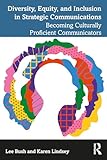Diversity, equity, and inclusion in strategic communications: becoming culturally proficient communicators
Material type: TextPublication details: Routledge New York 2025Description: xi, 180 pISBN:
TextPublication details: Routledge New York 2025Description: xi, 180 pISBN: - 9781032533865
- 302.2 BUS
| Item type | Current library | Collection | Call number | Copy number | Status | Date due | Barcode | |
|---|---|---|---|---|---|---|---|---|
 Book
Book
|
Indian Institute of Management LRC General Stacks | Public Policy & General Management | 302.2 BUS (Browse shelf(Opens below)) | 1 | Available | 008301 |
Browsing Indian Institute of Management LRC shelves, Shelving location: General Stacks, Collection: Public Policy & General Management Close shelf browser (Hides shelf browser)
Table of contents:
List of Contributors
Preface
Introduction
1. DEI Definitions, Theories, and Concepts
2. Understanding and Reaching Diverse Audiences
3. Centering DEI in Strategic Writing
Vanessa Bravo
4. Visual Storytelling: Reframing Diversity and Inclusion
Michele Lashley
5. Inclusive Digital and Social Media Strategies
Qian Xu
6. Designing Culturally Sensitive Research
7. Integrating DEI into the Campaign Planning Process
8. Working on Diverse Teams
9. Inclusive Leadership
10. Reputation Management and DEI
11. Communicating for Social Change
Glossary
Index
[https://www.routledge.com/Diversity-Equity-and-Inclusion-in-Strategic-Communications-Becoming-Culturally-Proficient-Communicators/Bush-Lindsey/p/book/9781032533865?srsltid=AfmBOoqGMDlFBts2dKxcItHAYUWZF21d3XU8vw95RstP9cpwFoglcIoT]
Taking a DEI-first approach, this book teaches students to become culturally proficient communicators by approaching diversity, equity, and inclusion (DEI) with intentionality in every aspect of strategic communications.
Those who work in strategic communications play a powerful role in shaping public perceptions and thus have a crucial responsibility to understand and practice the principles of diversity, equity, and inclusion in their work. This book introduces students to DEI theories and concepts and guides them through applying these concepts to communications research, planning, and execution. Chapters in the book align with the courses and competencies most often taught in advertising and public relations programs. It also includes chapters on “Inclusive Leadership” and “Working on Diverse Teams,” as students will need these competencies when working on group class projects and in preparing for internships. The concluding chapter on “Communicating for Social Change” allows students to look beyond advertising and PR as corporate-centered disciplines and expand their understanding of the power of communications to advocate for social justice and change.
Ideal for students at the undergraduate level with relevance to graduate students as well, the book can be used as a stand-alone text in DEI communications courses, as a supplement to core advertising or public relations texts, or in modules in advanced communications courses.
(https://www.routledge.com/Diversity-Equity-and-Inclusion-in-Strategic-Communications-Becoming-Culturally-Proficient-Communicators/Bush-Lindsey/p/book/9781032533865?srsltid=AfmBOoqGMDlFBts2dKxcItHAYUWZF21d3XU8vw95RstP9cpwFoglcIoT)
There are no comments on this title.








